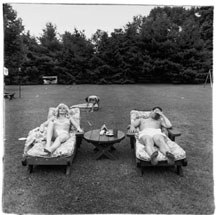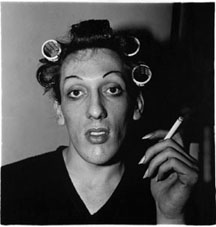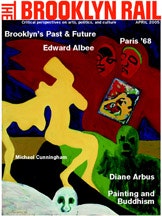Art
Diane Arbus: Revelations Beyond Shock
The Metropolitan Museum of Art
 Diane Arbus, “A family on their lawn one Sunday in Westchester, N.Y.” (1968).
Diane Arbus, “A family on their lawn one Sunday in Westchester, N.Y.” (1968).Copyright © 1968 The Estate of Diane Arbus, LLC.
In an era when our entertainment options include amateur Internet porn, Terri Schiavo’s death throes, and reality TV about on-screen surgery and love-hungry dwarves, it takes real effort to imagine how provocative Diane Arbus’s photographs were when they appeared in her first major show in 1967. That year her portraits of midgets, nudists, and transvestites were presented as part of New Documents at the Museum of Modern Art in New York. Arbus shared the bill with Lee Friedlander and Garry Winogrand, but at the time she got most of the press. Many of her reviews were positive, using terms like “brutal” and “daring” and “margins of society.” But The New York Times worried that her photography “borders close to poor taste,” and some visitors were reportedly so outraged by her men in rollers and garter belts that they were reduced to spitting at the pictures, like angry cats.
How quaint it all seems. Even culture warriors who might still profess to be offended by half-dressed drag queens can’t pretend to feel the innocent upset they would have thirty-eight years ago. And the blue-state-of-mind gallery-going public has spent years being subjected to sights far more grisly than anything Arbus ever came up with. Time and our society’s ever-greater sophistication (or decadence, or tolerance) have burnished away the superficial shock that once clouded our view of Arbus’s pictures.
Nevertheless, Diane Arbus Revelations reveals that Arbus’s images have not lost their ability to discomfit. These days, however, it is clearer that what moves us—whether to admiration or anger—is not her subject matter per se but the weave of motives and feelings. Take, for example, her well-known “Mexican dwarf in his hotel room, N.Y.C.” The man in the picture is sitting on an unmade bed in a rather seedy room, wearing nothing but a towel and a snappy little hat. His pose doesn’t emphasize his deformity but doesn’t conceal it, either; we immediately notice his pawlike hand and the odd angle of the foot emerging from underneath his towel. Despite his circumstances and his nakedness he gazes at the photographer, and therefore at us, with a rakish confidence that scotches any assumption that this interaction is about exploitation or ridicule. It’s hard for the viewer to match his élan, however: we cannot help feeling uneasy at finding ourselves on such intimate terms with a naked man who is, moreover, a Mexican dwarf.
 Diane Arbus, “A young man in curlers at home on West 20th Street, N.Y.C.” (1966).
Copyright © 1971 The Estate of Diane Arbus, LLC.
Diane Arbus, “A young man in curlers at home on West 20th Street, N.Y.C.” (1966).
Copyright © 1971 The Estate of Diane Arbus, LLC.Quite ordinary people, on the other hand, figure in Arbus’s picture of a suburban family lounging on the grass. They are prosperous and good-looking, but John Szarkowski, the MOMA curator of photography who championed Arbus’s work, called this picture “a real shocker—they’re in Dante’s last circle of the damned, but they don’t know it.” You can see what Szarkowski means. Then there’s the letter Arbus wrote gleefully describing how she approached the family matriarch in a bookstore, “about 35 with terribly blonde hair and enormously eyelashed and booted and probably married to a dress manufacturer or restaurateur.…They are a fascinating family. I think all families are creepy in a way.”
Yet there is nothing unkind about this portrait illustrating the creepiness of families; the people in it have not sacrificed their dignity. They may be lost in their vast sea of lawn, but they haven’t given up on the dreams that keep them afloat. Meanwhile the picture thrums with the strangeness of these normal suburbanites, who seem all the stranger for being, like most of us, largely oblivious to how peculiar their lives are.
“Someone told me it is spring but everyone today looked remarkable . . .” Arbus once wrote to a friend, “so absolute and immutable down to the last button, feather, tassel, or stripe. All odd and splendid as freaks and nobody able to see himself, all of us victims of the especial shape we come in.”
Arbus was herself very much a character, a New York archetype, a Jewish princess who grew up on Park Avenue and the Upper West Side, paid her dues as a fashion photographer and then walked away from respectability to become a struggling artist fascinated by freaks, misfits, and the infinite oddity of humankind. She also suffered from depression, and her suicide in 1971, at the age of 48, gave a tragic spin to the story. The catalogue of the retrospective the Modern mounted the year after she died quickly became a fixture on the bookshelves of aspiring bohemians alongside the poetry of Sylvia Plath.
Revelations, the first major assessment of the photographer’s work since that 1972 show, counters the reductive notion of Arbus the suffering artist with something far more interesting. The show premiered at the San Francisco Museum of Modern Art and was put together by SFMOMA’s senior curator of photography, Sandra S. Phillips, and independent curator Elisabeth Sussman with the active participation of Arbus’s older daughter, Doon, who manages the Arbus estate. Previously the estate had been famously unwilling to make public anything beyond a small number of images. Now, however, Revelations and its huge, delicious catalogue offer a wealth of photographs, early and late, including many never seen before, as well as an abundance of biographical data and selections from Arbus’s high-spirited, witty writings. Also on exhibit are her cameras, books from her library, pages from her notebooks, postcards, letters, and re-creations of the walls in her apartment on which she tacked news clippings, flyers, photographs, whatever intrigued her.
What we learn is that Arbus was neither a morbid waif nor a simple-minded thrill-seeker but an ambitious artist whose curiosity about the human experience was enriched by her exploration of art history, myth, psychology and literature. “She was serious, but in a very lively way,” recalled Szarkowski. “She was full of intellectual gaiety.”
Although Revelations has bolstered Arbus’s artistic reputation, she still has her detractors. The tone was set by Susan Sontag’s notorious 1973 critique. “Arbus’s work shows people who are pathetic, pitiable, as well as horrible, repulsive, but it does not arouse any compassionate feelings,” Sontag contended. Instead the pictures indulge in a fashionable pessimism “based entirely on distance, on privilege, on a feeling that what the viewer is asked to look at is really other.” More recently, critics have complained of Arbus’s “failure to get past a private narrative” and called her work morbid and exploitative. Particularly offensive to this point of view is Arbus’s late work, a stunning series of pictures taken at state institutions for the retarded. Even more than the sideshow denizens and Washington Park weirdos who first made Arbus famous, these profoundly disabled women seem, to Arbus’s critics, too helpless to be subjected to her gimlet eye and too tragic, too frightening for the rest of us to look upon.
Arbus’s defenders, including the curators of Revelations, insist that she approached her subjects with compassion rather than contempt. “Her refusal to patronize the people she photographed, her acceptance of the challenge of the encounter, constitutes a deep and abiding humanism,” Phillips writes in the Revelations catalogue. Instead of the snickering, déclassé cynic conjured up by Sontag et al., we have, as one of Arbus’s detractors peevishly put it, “Saint Diane, tending to her flock.” Now that the shock value has drained out of Arbus’s pictures, her critics’ complaints seem more wide of the mark than ever, full of creaky modernist nostalgia for art whose emotional demands are safely abstract. Aren’t they attributing to Arbus their own revulsion and blaming her for their own lack of imaginative sympathy?
It’s also true, however, that Arbus was not piously focused just on her subjects’ humanity. Her writings and the photographs themselves reveal her giddy pleasure in their weirdness and absurdity. Thus a letter to her daughter Amy, describing a visit to “the retarded school,” says, “One of the best times was when they played Simon Says in a field. Its really a very serious game for them because when Simon says raise your hands high, some can some cant some only just put their hands on their head. And when Simon says run in place the ones that can do it as if it was nearly impossible. Lots of them are pearshaped.…” A jotting in one of her notebooks reads, “Morons, 50-69; imbeciles, 20-50; idiots, under 20.” As Janet Malcolm pointed out in her 1996 review of these pictures, “She does not flinch from the truth that difference is different, and therefore frightening, threatening, disgusting.”
That is not the whole point of Arbus’s photographs, but it is a necessary starting point. Shame, awe, and the thrill of looking at things that politeness or prudery bids us to turn away from energizes Arbus’s art. Her genius lay in her openness to the ways that same energy, that same unease and curiosity, flowed back at her from her subjects, and in her ability to capture that highly charged emotional exchange in unforgettable images. As a result, her photographs manage to be scary, beautiful, comic, heartbreaking, scathing, tender, all at the same time. They fill you with a peculiar mixture of elation and ache, helplessness and infinite possibility.
We are not looking down on the people in these photographs, nor are we looking up to them. Rather, we gaze into their eyes and find ourselves disarmed by unexpected kinship. Consider Arbus’s picture of “Two ladies at the automat.” At first, the more we look at the pair of well-dressed matrons enjoying their cigarettes, the odder they seem. Their pale makeup, painted-on eyebrows, and emphatic cheekbones make their faces look like primitive masks, an effect heightened by their tall hats. Is this afternoon coffee or some savage rite?
We don’t doubt for a minute that Arbus was amused by these ladies and their eyebrows. The women hold their own, however. They appear to be amused by Arbus, too, this little beatnik photographer with her chopped-off hair and battered camera bag. If they are funny looking, well then, who isn’t? The people around you are, gazing at Arbus’s pictures. You are, after all.




